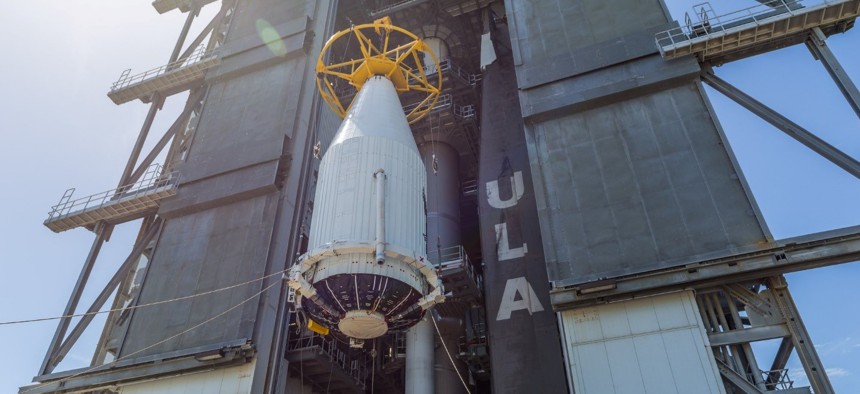New missile defense tech comes with acquisition risks

The sixth Space Based Infrared System Geosynchronous Earth Orbit satellite sits atop its Atlas V rocket for launch Aug. 4, 2022. Photo courtesy of United Launch Alliance
Space Systems Command is seeking guidance on how to manage the procurement of a ground-based command and control system that combines legacy systems with the next generation of missile defense satellites.
Space Systems Command is looking for ideas to reduce the risks in transitioning satellite-based missile detection and defense systems from a legacy command and control system to new infrastructure.
The project involves migrating existing satellite assets in the Space-Based Infrared Systems to a new command and control solution, dubbed Future Operationally Resilient Ground Evolution (FORGE). In a request for information posted earlier this month, Space Systems Command said it wanted guidance on contracting strategies and other challenges posed by the program's timeline and complexity. There are three sets of satellite capabilities due to transition away from the legacy command and control system and on to FORGE by 2026.
FORGE is expected to integrate data from the legacy Space-Based Infrared Systems and the Next Generation Overhead Persistent Infrared system expected to come online in 2025.
"That will be a really powerful capability to provide our operators, because they won't have to look at a lot of different screens, one for each satellite," Col. Rhet Turnbull, deputy director of the Space Systems Integration Office, said in June, according to a report in DefenseOne.
But combining multiple systems under a single command and control infrastructure poses technological and operational challenges. Space Systems Command is apparently concerned about risks associated with the government serving as lead integrator on the multi-pronged project, with different vendors supplying software, hardware and other capabilities.
"Recommendations may include combining some or all elements under a single provider," the solicitation states. "The government is also interested in lessons learned with respect to the highest risks associated with ground system software integration. This response should also include information on any successfully implemented integration approaches that have been executed on similar programs."
The solicitation also seeks guidance on the extent to which the government should furnish platforms and infrastructure and what role satellite providers should play in command and control solutions contracts. Space Command Systems is also looking to minimize the use of special purpose applications across the command and control system and indicates that software should be "platform agnostic" and function across other infrastructures and platforms.
Data is another concern. Under the terms of the acquisition, the government will own the FORGE command and control solution technical baseline. The solicitation asks how vendors would handle "potential challenges or limitations that come with providing appropriate data rights to the government."
The solicitation also asks vendors whether a firm fixed price contract for the command and control acquisition makes sense, considering the prevalence of such systems in the public and private sectors. Space Command Systems indicates that a firm fixed price acquisition is under consideration.
Vendors have until August 31 to respond.



